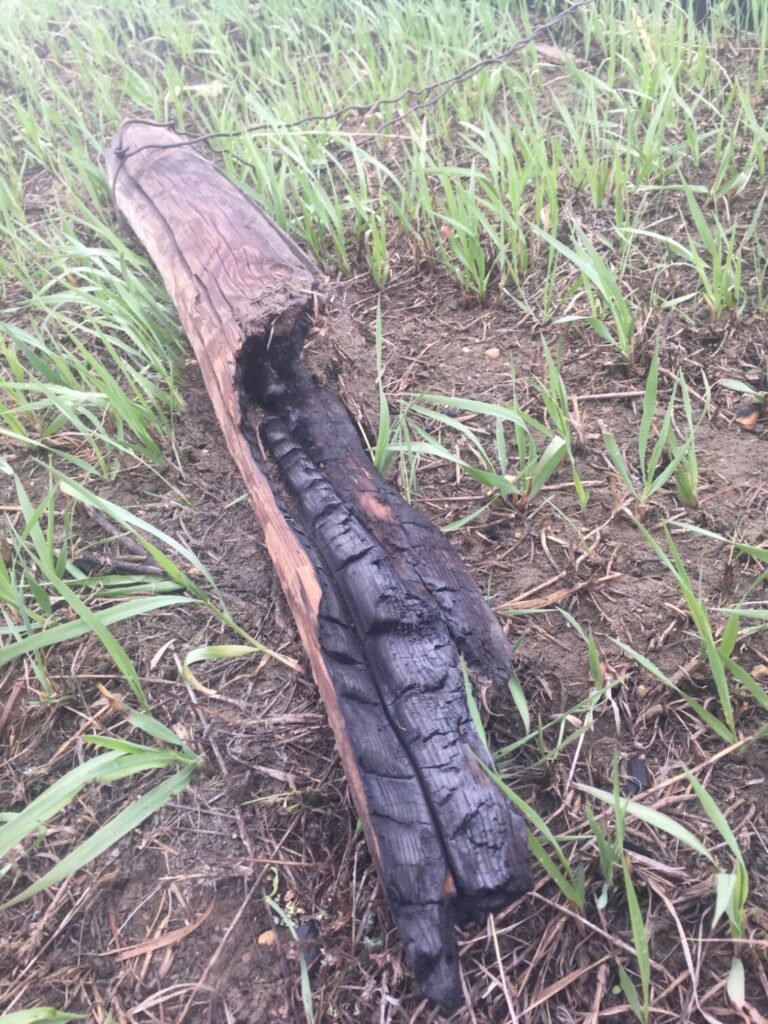AB Direct - Steers
Rail: 487.50-493.50 FOB feedlot (last week)
AB Direct - Heifers
Rail: 487.50-493.50 FOB feedlot (last week)
US Trade- Steers
Rail: 340.00-347.00 (IA, NE) last week
US Trade - Heifers
Rail: 340.00-347.00 (IA, NE) last week
Canadian Dollar
0.09
When the heat is on: pasture recovery after fire or drought
Following years of drought and a record-breaking wildfire season, pastures across Alberta are in poor condition. We asked rangeland ecologist Cameron Carlyle to bring us up to speed on the situation and provide some recommendations on how to help pastures recover.
Across Alberta, wildfires and drought reduced available grazing acres in 2023, resulting in heavy use on grazable land. Whether as a result of drought, fire or overgrazing, damaged pastures need time to recover and, given adequate moisture and rest, they usually will.
The effects of fire and drought on a pasture differ, both at the surface level and below it. Fire generally does the most damage to the surface, stripping all vegetation including important plant litter. Drought damages both plant vigour on the surface and root reserves deeper in the soil.
How quickly pastures recover from both kinds of damage depends heavily on moisture. “The litter layer is super important for holding moisture in the ground and contributing to forage production, and in a fire all the vegetation burns up,” explains Cameron Carlyle, Associate Professor of Rangeland Ecology at the
University of Alberta. “In drought conditions, plants have less root energy reserves and less vigour because they didn’t have the same growth opportunity the year before.”
Carlyle has been active in pasture productivity research in Alberta for many years. In one study, his team looked at grassland recovery following grass fires in southern Alberta and southern Saskatchewan in 2017, comparing grazed versus ungrazed areas. While grazing impacted forage recovery, the biggest single factor was rainfall. “When the rain came, that’s when we started to see recovery,” he says.
Long-range forecasts suggest rainfall in 2024 may not be sufficient in many areas of the province. While we can’t make the rain fall, Carlyle offers some valuable suggestions based on his research to support pasture recovery.
MAINTAIN HEALTHY PASTURES

In every corner of the province, making a concerted effort to maintain rangeland health is important. It increases resilience in case of either fire or drought. “Generally we find that drier areas of the province tend to be more sensitive to drought and to overgrazing, and possibly that is true of fire as well,” says Carlyle.
Carlyle’s research found that areas that had higher range health prior to fire recovered a bit faster. “This suggests that maintaining good range management practices does help provide some resilience when fires happen,” he says.
GIVE IT A REST
On drought or fire-damaged acres, support recovery by providing adequate rest. Carlyle’s grassland fire recovery research found that grazing during the recovery period slowed the development of surface litter. “It might look okay if there is rainfall and you see plants growing, but the litter layer needs time to develop to create drought resilience in the system,” he says.
The only constant is knowing that conditions will continue to change.
MONITOR RECOVERY

While allowing a pasture to rest, producers can monitor plant height and vigour, and watch for changes in the types of vegetation present. The key following a fire is to focus on the developing litter layer. “You can take photos or do a litter scrape in the years following a fire to see how well the litter layer is developing over time,” Carlyle suggests.
PATIENCE PAYS OFF
Generally, Carlyle recommends practicing patience. “Monitor forage growth and reduce stocking rates on drought or fire affected areas as much as possible,” he says.
The amount of time required for damaged pastures to recover varies. Carlyle’s research found that after four years, forage production on grassland recovering from fire returned to the same level as it was in areas that hadn’t burned. But even after four years, the litter layer hadn’t recovered. He adds: “Other studies have shown that where there was above average rainfall in the years following drought or fire, recovery happened very quickly. So, it depends.”
CHANGE IS A CONSTANT
There’s no question – producers dealing with drought or fire damaged pastures are in a tough situation right now, and the only constant is knowing that conditions will continue to change. Hopefully, for the better.
“Producers have to graze when animals need to be fed,” says Carlyle. “But if possible, I recommend avoiding grazing for a year on an area that burned. Following drought, the same applies – as much as possible, you want to reduce the use of those pastures.”
AMP GRAZING
A type of rotational grazing system gaining traction in parts of Canada may offer promise for dealing with
drought while supporting higher grass production. Adaptive multi-paddock (AMP) grazing involves rotating animals through small pastures at high density for short periods of time.
AMP grazing can involve a number of different practices, but specifically requires a more intensive
level of management, giving ongoing attention to pasture conditions in each paddock. “AMP grazing gives producers more control of what’s being done to the plants through grazing, and that’s part of the
benefit,” says Cameron Carlyle, Associate Professor of Rangeland Ecology at the University of Alberta.
What is “adaptive” in the system is that most producers monitor paddocks closely and move animals frequently from one area to the next. “Generally they are moved more frequently as compared to other systems such as continuous grazing or rotational systems, where they
move two or three times a year,” Carlyle says.
Another strategy that can boost forage production is using bale grazing to restore degraded areas. “Bale
grazing imports a lot of organic material. The animals are there, eating that material there, trampling and defecating there, so it adds nutrients and organic matter to areas
where it’s needed,” says Carlyle.
AMP producers are self organizing, and there are individuals and groups hosting workshops and meetings about how to implement this type of system,” Carlyle explains. “Most of the producers I’ve talked to say that’s how they got into it.”
The results of a study comparing 30 western Canada ranches practicing AMP grazing to neighbouring ranches that did not practice AMP grazing showed a 20 per cent increase in plant production and an improvement in water filtration rates as well. Carlyle says, “Those two things combined suggest that moving to an AMP system could be beneficial, and may offer some promise in dealing
with drought.”
In a drought, there is less water available, and forage production goes down. “But if the water that does come down is able to get into the ground, it is probably going to provide some resiliency so you can maintain slightly better forage production even in a drought,” says Carlyle.
An AMP system may support pasture health and reduce the impact of drought, but it’s important to consider that it takes significant time, infrastructure and effort to develop. “You can’t implement this overnight, or switch to AMP grazing and have higher production capacity quickly. It would take five to 10 years or even more to get there,” Carlyle adds.
This article was first published in Volume 4 Issue 1 of ABP Magazine (February 2024). Watch for more digital content from the magazine on ABP Daily.


